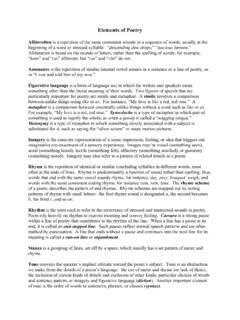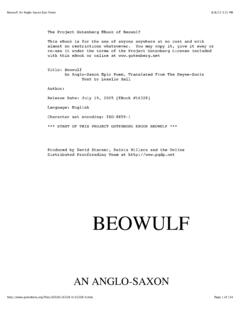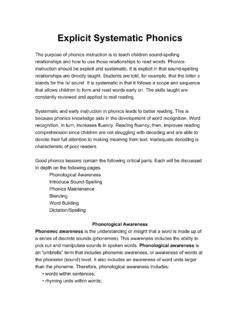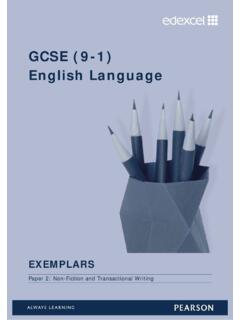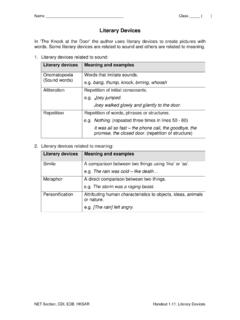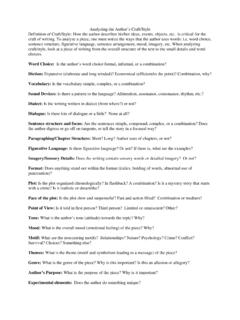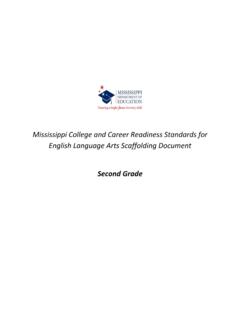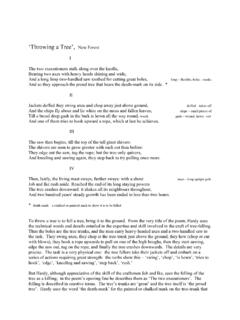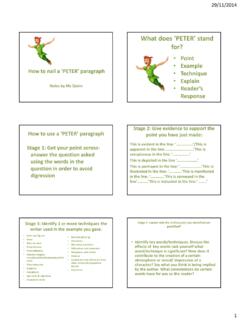Transcription of The Highwayman Poem Analysis
1 The Highwayman Poem Analysis The Highwayman is 1906 poem written by Alfred Noyes that addresses a social phenomenon, love. It is a romantic poem about a woman sacrificing her life for her criminal lover s safety. The narrator speaks to the reader in this poem and it s clear by the end that The Highwayman is a ghost story. As for the setting, the language makes it seem like an old story from 18th century England. There are many words that contribute to the dark and spooky atmosphere, especially the few lines of the first stanza that set the mysterious tone right away. The diction adds to the poem by the mention of the wind and moon multiple times throughout. The wind sets the intense and chaotic feeling right at the beginning and near the end, while the moonlight makes the setting eerie and romantic at the same time.
2 Even the description in the 3rd stanza of the Highwayman riding over the cobbles in the dark inn yard shows he lives a dangerous and action filled life. Most of the words are concrete but there are some abstract terms such as love. The tone of The Highwayman can be described as romantic, spooky and intense. There is a change of tone during the lines, then he tugged at his rein in the moonlight, and galloped away to the west, and he did not come in the dawning, he did not come at noon. It shifts from a romantic, warm feeling, to a worried and tense feeling about the fate of the Highwayman . The mood starts off majestic and hopeful but turns to sorrow and sadness at the end when we find out that the Highwayman still dies even after Bess sacrifice.
3 This narrative poem takes a closed form since it has set structures such as stanzas of 6 lines and an end rhyme scheme: AABCCB. There is also internal rhyme in the 10th stanza, wet with sweat . Another thing to note is that the 4th and 5th line of every stanza are shorter than the rest of the lines. They either repeat or continue off of each other. For example in stanza 5, Then look for me by moonlight, and Watch for me by moonlight. Alfred Noyes uses many poetic devices in this poem. There is allusion of King George in at the end of stanza 7 referencing to the King of England during the 18th century. Many sound devices can be found as well such as alliteration , consonance and onomatopoeia. Some examples of alliteration include, ghostly galleon , breeches of brown, and she stood up, straight and still, whereas press me sharply, and harry me through, displays consonance due to the repeating r sound.
4 The tlot tlot! of the horse s hooves and clatter , clash and whistle are examples of onomatopoeia. This poem is also full of figurative language. The poem starts off with three metaphors in a row: The wind was a torrent of darkness , The moon was a ghostly galleon and The road was a ribbon of moonlight . There are similes throughout the poem such as dumb as a dog , hair like mould hay , face was like a light and face burnt like a brand. Repetition is very evident in this poem, not just in the 4th and 5th line of every stanza but also at the end. The 1st and 3rd stanza repeats itself to conclude the ghost story, only altering the first line to And still of a winter s night, they As for hyperbole and personification, there is a line in the 10th stanza that states, and the hours crawled by like years.
5 This is an exaggeration since hours are not as long as years yet also a personification, giving the human attribute of crawling to time. There are plenty of symbols throughout the poem. One of the most apparent symbols, is the use of the colour red as an adjective. When it is used the first time, it s describing the red love knot that Bess is tying in her hair. This represents love, passion and youthfulness. The next time it is used is when King George s men come marching into the inn to find the Highwayman . The colour red this time, represents violence and destruction. We also see this use of red when the Highwayman is shot dead on the road, again, symbolizing death and violence. Another big symbol is the musket that killed both Bess and the Highwayman .
6 The musket symbolizes sacrifice and warning in Bess case. She used the musket to kill herself in order to warn the Highwayman , professing her love for him as well with the act. A few other symbols are the moonlight, representing secrecy and hiding. Another is the inn, representing safety, quiet and comfort where love is easily created. The theme of the Highwayman is definitely centered around love and sacrifice. There are many other little themes, such as courage or violence but the overall theme of this poem is that to die for someone else s life, is the greatest sacrifice of love that one can give.










